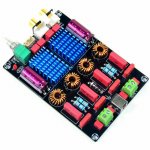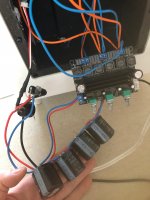HELP!!!! i just hooked up my tpa 31162d to my linear PSU 24v 12 amps.
i can't get pass get not even 1/4 of the volume the the sounds keeps getting cut off. tried it with 15vdc 2 amps and same thing
happens.
What is your speaker impedance? The sound level when the amplifier starts cutting off, would you characterize it as loud or moderate?
Which are the output filter chokes used for the TPA3116D2 amplifier (eventually a photo of the board)?
i tested it with 6 0hms yamaha sattelite speakers, amp starts cutting off at relatively low volume i cant even get pass 8 oclock on the volume knob . im not sure about the chokes or if it has one. as im very new to this kind of topology and or any SMDs for that matter. heres the board itself. its very frustrating.
An externally hosted image should be here but it was not working when we last tested it.
What is your speaker impedance? The sound level when the amplifier starts cutting off, would you characterize it as loud or moderate?
Which are the output filter chokes used for the TPA3116D2 amplifier (eventually a photo of the board)?
Last edited:
How is the heat sink fastened to the board? Could the heat sink be shorting out 2 or more surface mount components underneath it?
How is the heat sink fastened to the board? Could the heat sink be shorting out 2 or more surface mount components underneath it?
screwed down the board, with a rubber spacer in between.which is the same height as the chip. i probably just have a lemon. never had a problem like this before. btw, after a certain position of the volume knob. the signal gets completely cut and there would be pulsating sound out of the speakers.
i tested it with 6 0hms yamaha sattelite speakers, amp starts cutting off at relatively low volume i cant even get pass 8 oclock on the volume knob . im not sure about the chokes or if it has one. as im very new to this kind of topology and or any SMDs for that matter. heres the board itself. its very frustrating.
6 Ohm speakers should be fine.
The filter chokes should not be a problem.
The 8 o'clock, or 9 o'clock for that matter, does not tell the power level at the output. The input level and the amplifier gain decides the output level.
A TPA3116 amplifier can play rather loud, even from 15 Volt, before cutting at the output. Continue with the 15Vdc as supply until it seems to work.
My suggestion, try removing the heatsink and use the 15Vdc supply. A TPA3116 can work without heatsink with 6 Ohm speakers. Without heatsink, does it then work?
In particular your 24V supply has a huge static current capacity but how much capacitance does it have? Your board only has some 6x330uF.
Last edited:
Hi,
I bought this module from Amazon India just to taste digital sound.
LINK
After few days it stopped working. However the power on LED blinks(earlier it stayed on). Is this a known problem to be solved easily by a newbie.
thanks and regards.
Hi,
What is your supply voltage? speaker impedance?
Please measure DC-resistance of the output with disconnected speaker while unpowered to see if anythings wrong there.
Uhhhg! Sucks! The actual amp is the problem. Tried it with a 19vdc 3.5 amps laptop charger and the problem is still there. Actually its worst bec. the amp gets cut out with lower volume level than my over specd lpsu. Oh well. Thank you all guys. Will try another board and or another chip than can take 24vdc 12 amps😉 any suggestions?
Hi, fauxfrench, doctormord
My supply voltage written on powersupply as well as measured is 18.5 V, 3.5 A (Laptop power supply) Speaker Impedance is 8 Ohms.
Dont know if DC resistance measurement is meant for me; but I measured it with no power and disconnected speakers. On 200k DMM setting it is 157k on one channel and other channel shows open.
My supply voltage written on powersupply as well as measured is 18.5 V, 3.5 A (Laptop power supply) Speaker Impedance is 8 Ohms.
Dont know if DC resistance measurement is meant for me; but I measured it with no power and disconnected speakers. On 200k DMM setting it is 157k on one channel and other channel shows open.
Hi, fauxfrench, doctormord
My supply voltage written on powersupply as well as measured is 18.5 V, 3.5 A (Laptop power supply) Speaker Impedance is 8 Ohms.
Dont know if DC resistance measurement is meant for me; but I measured it with no power and disconnected speakers. On 200k DMM setting it is 157k on one channel and other channel shows open.
Hi Hiten,
18.5V/3.5A is fine - not near the maximum voltage and not near the minimum voltage.
8 Ohm is also fine.
Generally, if you feed an amplifier board with a supply voltage around the middle of its voltage range, connect speakers of higher impedance (8 Ohm is fine) and without input signal, the fault indicator (the blinking LED) should not be activated. If it is anyway activated, it is very likely that the board has a fault.
A board fault is not easy to repair for a "newbie" because most of the components are very small.
What you can do and seem already to have started, is to measure (without supply power) the impedance from all four output terminals (one at a time) to power supply ground ("-") and to power supply "+". Any impedance below 100 Ohm is an indication of a defect chip. Changing the chip is not easy.
Hi Hiten,
18.5V/3.5A is fine - not near the maximum voltage and not near the minimum voltage.
8 Ohm is also fine.
Generally, if you feed an amplifier board with a supply voltage around the middle of its voltage range, connect speakers of higher impedance (8 Ohm is fine) and without input signal, the fault indicator (the blinking LED) should not be activated. If it is anyway activated, it is very likely that the board has a fault.
A board fault is not easy to repair for a "newbie" because most of the components are very small.
What you can do and seem already to have started, is to measure (without supply power) the impedance from all four output terminals (one at a time) to power supply ground ("-") and to power supply "+". Any impedance below 100 Ohm is an indication of a defect chip. Changing the chip is not easy.
I thought that blue LED is the power indicator. Lol
I thought that blue LED is the power indicator. Lol
Without knowing the exact design of that board, often the "power LED" is connected to a status pin of the chip. As the status is normally "all fine", the LED is normally ON and we see it as a mere power LED.
If it is a true power LED just connected to the power supply lines and it starts blinking, then the power supply line is repeatedly shorted with the frequency of the blinking. It is possible with such a hick-up situation but then I am quite certain the chip is burned.
Yes I can solder but replacing tiny chip is difficult. So I will leave it as is.What you can do and seem already to have started, is to measure (without supply power) the impedance from all four output terminals (one at a time) to power supply ground ("-") and to power supply "+". Any impedance below 100 Ohm is an indication of a defect chip. Changing the chip is not easy.
Thanks and regards
Hi. Does anyone have an opinion on this board (see attachment), have you tried it for sound quality, how does it compare with rival tpa3116 boards. It has been mentioned on this thread but no feedback.
Thanks
You are right, it would be nice with someone who has experience with this board (I do not).
Looks nice but I have two less appreciating comments:
The heatsinks seems to be glued to the TPA3116 chips and the power line decoupling capacitors are 2x680uF which is little for a PBTL-coupled amplifier (for low impedance loads).
there are boards out there with wrong component values in the feedback network creating instability. it's somewhere on this forum
I am liking the lack of components in the signal path, perhaps giving a cleaner sound.
If purchasing this would you be tempted to remove the board componenets and replace with genuine.
I am also looking at the lm3886 and similarly it has very few components to get in the way of the signal, but the cost of the populated board on ebay is impossble for me to duplicate, it makes me wonder if the components are genuine.
Have you ever thought about that, stripping down to the bare board and re-populating yourself with higher quality resistors, caps, genuine ic's etc. Is this a considration or am i just being paranoid.
Thanks
If purchasing this would you be tempted to remove the board componenets and replace with genuine.
I am also looking at the lm3886 and similarly it has very few components to get in the way of the signal, but the cost of the populated board on ebay is impossble for me to duplicate, it makes me wonder if the components are genuine.
Have you ever thought about that, stripping down to the bare board and re-populating yourself with higher quality resistors, caps, genuine ic's etc. Is this a considration or am i just being paranoid.
Thanks
He guys
I'm back. I had always the same stops at high volume. I just soldred 4 10000uF caps and yet no problem.
I think my powerbank has to high impedance :-(
Powerbank is 4P5S Panasonic CGR18650 2250mAh so its 18V 9Ah. Thins one I had two pieces :-D
I had another powerbank with Panasonic NCR18650 2900mAh with bigger 11.6Ah capacitance.
I'm back. I had always the same stops at high volume. I just soldred 4 10000uF caps and yet no problem.
I think my powerbank has to high impedance :-(
Powerbank is 4P5S Panasonic CGR18650 2250mAh so its 18V 9Ah. Thins one I had two pieces :-D
I had another powerbank with Panasonic NCR18650 2900mAh with bigger 11.6Ah capacitance.
Attachments
He guys
I'm back. I had always the same stops at high volume. I just soldred 4 10000uF caps and yet no problem.
I think my powerbank has to high impedance :-(
Powerbank is 4P5S Panasonic CGR18650 2250mAh so its 18V 9Ah. Thins one I had two pieces :-D
I had another powerbank with Panasonic NCR18650 2900mAh with bigger 11.6Ah capacitance.
So, with the 4x10000uF caps in parallel with the batteries, it works?
I recall someone, perhaps Turbowatch, mentioning that batteries have a delay in providing current. Perhaps this is just evidence of such an effect in batteries.
- Home
- Amplifiers
- Class D
- TPA3116D2 Amp

